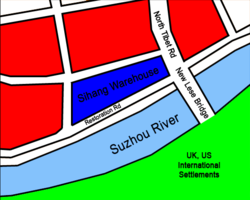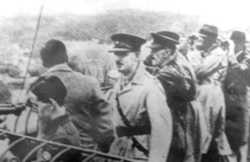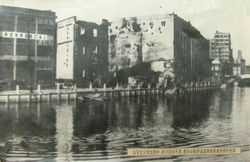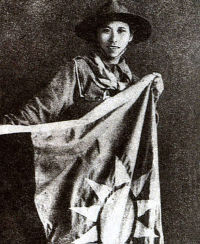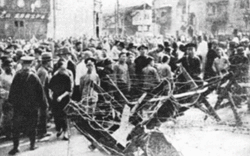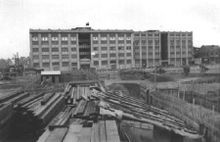Defense of Sihang Warehouse
2007 Schools Wikipedia Selection. Related subjects: Military History and War
| Defense of Sihang Warehouse | |||||||
|---|---|---|---|---|---|---|---|
| Part of the Battle of Shanghai in the Second Sino-Japanese War |
|||||||
 A painting of the Defense commissioned by the Nationalist government |
|||||||
|
|||||||
| Combatants | |||||||
|
524th Regiment, 88th Division, National Revolutionary Army |
3rd Division, Imperial Japanese Army |
||||||
| Commanders | |||||||
| Xie Jinyuan | Iwane Matsui | ||||||
| Strength | |||||||
| 414 men including 16 officers | Unknown, but far more than the Chinese | ||||||
| Casualties | |||||||
| 27 wounded, 10 killed | More than 200 killed | ||||||
| Second Sino-Japanese War |
|---|
| Major engagements in bold Mukden - Invasion of Manchuria -( Jiangqiao - Nenjiang Bridge - Chinchow - Harbin) - Shanghai (1932) - Operation Nekka - ( Rehe - Great Wall) - Suiyuan - Marco Polo Bridge - Beiping-Tianjin - Chahar - Shanghai (1937) (Sihang Warehouse) - Beiping-Hankou Railway - Tianjin-Pukou Railway - Taiyuan - ( Pingxingguan) - Xinkou - Nanjing - Xuzhou- Taierzhuang - N.-E.Henan - ( Lanfeng) - ( Amoy) - Wuhan - Canton - ( Hainan) - ( Xiushui River) - Nanchang - Suixian-Zaoyang - ( Swatow) - 1st Changsha - S.Guangxi- ( Kunlun Pass) - Winter Offensive -( Wuyuan) - S.Henan - Zaoyang-Yichang - Hundred Regiments - Indochina Expedition - Shanggao - S.Shanxi - 2nd Changsha - 3rd Changsha - Yunnan-Burma Road-( Yenangyaung)- Zhejiang-Jiangxi - W.Hubei - N.Burma-W.Yunnan - Changde - C.Henan - 4th Changsha - Guilin-Liuzhou - W.Henan-N.Hubei - W.Hunan- 2nd Guangxi edit |
The Defense of Sihang Warehouse ( Traditional Chinese: 四行倉庫保衛戰; Simplified Chinese: 四行仓库保卫战, pinyin: Sìháng Cāngkù Bǎowèi Zhàn) took place from 26 October to 1 November 1937, and marked the beginning of the end of the three-month Battle of Shanghai in the opening phase of the Second Sino-Japanese War. The defenders of the warehouse, popularly known as the Eight Hundred Heroes ( Traditional Chinese: 八百壯士; Simplified Chinese: 八百壮士, pinyin: Bābǎi Zhùangshì) or the Lone Battalion, held out against numerous waves of Japanese forces and covered the movements of the Chinese forces retreating west during the Battle of Shanghai. The successful defense of the warehouse provided a morale-lifting consolation to the Chinese army and people in the demoralizing aftermath of the Japanese invasion of Shanghai. The warehouse's location just across the Suzhou River from the foreign concessions in Shanghai meant the battle took place in full view of the western powers. This drew the attention, if only briefly, of the international community to Chiang Kai-shek's bid for worldwide support against Japanese aggression.
Background
Using the Marco Polo Bridge Incident as the pretext, Japan launched an invasion of China on 7 July 1937. As the Imperial Japanese Army swept down from the north, fighting between Chinese and Japanese forces started in Shanghai on 13 August. Despite having logistical problems, inferior training, and a lack of air and artillery support, the Chinese held on to Shanghai City, much of it reduced to ruins. The Japanese, however, did not attack the foreign concessions and remained on peaceable terms, though there was pressure on both sides. They would not occupy the concessions until four years later, following Japan's decision to go to war with the Allies.
By 26 October 1937, Chinese resistance in the district of Zhabei was faltering. Generalissimo Chiang Kai-shek wanted to withdraw all forces in the area to defend the rural western regions of Shanghai, and ordered Gu Zhutong (顾祝同), acting commander of the 3rd Military Region, to leave the 88th Division behind to buy time and canvass international support by showing the other powers of the Nine Powers, convening on 6 November, China's determination to resist the Japanese war of aggression. Gu was personally attached to the 88th and unwilling to leave the division behind, as he was the commander of the 2nd Division, which became the 88th after reorganisation. He telegraphed the 88th's divisional commander Sun Yuanliang (孙元良), who vehemently opposed this plan and sent his chief of staff Zhang Boting (张柏亭) to Gu's Headquarters, about 20 km from the frontlines, to argue against it.
Neither Gu, Sun nor Zhang were about to disobey Chiang's orders, but Sun (via Zhang) suggested to Gu that the number of troops left to cover the withdrawal would not matter for such a show of determination. In his words, "It would achieve the same purpose no matter how many people we sacrifice." He proposed that a single regiment be left behind to defend one or two fortified positions, and Gu approved the plan. Zhang returned to the 88th's divisional headquarters at Sihang Warehouse. Back at the headquarters, Sun decided that even a regiment would be a terrible waste of lives and decided on a single over-strength battalion instead. Xie Jinyuan, a relatively new commander to the 88th Division, volunteered to lead the battalion.
At 10 p.m. on 26 October, the 524th Regiment, based at the Shanghai North Railway Station, received orders to withdraw to the divisional headquarters at Sihang Warehouse. 1st Battalion commander Yang Ruifu was distraught at having to abandon a position he had held for more than two months, but agreed to do so after being shown Sun's orders for the 1st Battalion to defend Sihang Warehouse.
The warehouse, known also as the Chinese Mint Godown by those from the concessions, is a six-story concrete building situated in Zhabei District north of Suzhou Creek, at the north-western edge of New Lese Bridge (now North Tibet Road Bridge). Built jointly by four banks — hence the name Sihang (literally, Four Banks) — in 1931, it sits on a 0.3- acre (0.12 ha) plot of land, with an area of 20,700 square metres (222,800 sq ft), 64 metres (210 ft) wide by 54 metres (177 ft) long, and 25 metres (82 ft) high, making it one of the tallest buildings in the area. The warehouse, used as the divisional headquarters of the 88th Division prior to the battle, was stocked with food, first aid equipment, shells and ammunition.
Order of battle and equipment
National Revolutionary Army
- 524th Regiment, 88th Division - Regimental commander, Army Lieutenant Colonel Xie Jinyuan
-
- Regimental commander, Army Major Shangguan Zhibiao (上官志标)
-
- 1st Battalion, 524th Regiment - Battalion Commander, Army Major Yang Ruifu (杨瑞符)
-
- 1st Company, 1st Battalion - Company commander, Army Captain Tao Xingchun (陶杏春)
- 2nd Company, 1st Battalion - Company commander, Army Captain Deng Ying (邓英)
- 3rd Company, 1st Battalion - Company commander, Army Captain Shi Meihao (石美豪, wounded), Army Captain Tang Di (唐棣)
- Machine Gun Company, 1st Battalion - Company commander, Army Captain Lei Xiong (雷雄)
Initially containing around 800 men, it was technically an over-strength battalion, but casualties suffered over the course of the war made it actually below strength, at 423 men, including officers. As a further reduction in strength, only 414 were present during the battle. Some sources give 453 as the paper strength of the battalion, and due to the confusion of the general retreat, it is possible some groups failed to make it to the battle. Two months of intense fighting had also whittled down the original German-trained troops, and after five reinforcements, the majority of soldiers and officers in the battalion were garrison troops from the surrounding provinces. Most of the men were from the 1st Battalion, 5th Regiment of the Hubei Provincial Garrison. Hubei also did not want to send its well-trained troops, built over a decade to fight against the Chinese Communists, to Shanghai. Thus ultimately many of the soldiers sent as reinforcements to Shanghai were green recruits, with the latest batch recruited after the outbreak of war on 7 July. Though the 1st Battalion was not the only battalion in the 524th, it was by far the most famous after the battle. Eventually the 1st came to be equated with the 524th, even within official documents of the period.
The regiment was assigned used equipment from the front-line troops of the 88th. Photos and records show that every soldier was issued a rifle, likely a Gewehr 88 or Gewehr 98, 300 rounds of 8 mm Mauser, two crates of grenades, a German-made M1935 helmet, a gas mask, and food pouch. There were a total of 27 light machine guns, mostly of the Czech ZB vz.26, approximately one for each squad. The four water-cooled Type 24 Maxim guns were the only heavy weapons available to the regiment — a mortar platoon assigned to them was never mentioned by participants of the battle, and was therefore unlikely to have joined the battle.
Imperial Japanese Army
- Shanghai Expeditionary Force - General Iwane Matsui
-
- 3rd Division
The Japanese 3rd Division (the most elite IJA division at the time) had access to armoured vehicles, likely Type 94 Te-Ke tankettes, and also Type 89 mortar teams. Japanese infantry used the Arisaka Type 38 Rifle.
27 October
The various companies of the battalion were spread out across the front lines that night. Yang Ruifu sent the 1st Company to Sihang Warehouse and personally led the 2nd Company. The 3rd Company, Machine Gun Company and part of the 1st Company could not be contacted. What initially seemed a disastrous start to the defence was averted at nine in the morning, when these companies turned up at the warehouse, having heard the orders through word of mouth from other forces that had retreated from Zhabei. That these men essentially volunteered for this suicidal mission was later noted by Chiang Kai-shek as exemplary soldierly conduct.
In early morning, news circulated throughout Shanghai that there were still Chinese forces defending Zhabei at Sihang Warehouse. This piqued the interest of Girl Guide Yang Huimin, who would later play a large part in this battle. At around 4 a.m. she walked to the British guard post at the Chinese end of New Lese Bridge, where she noticed the British soldier throwing a pack of cigarettes into the warehouse. She asked the soldier what he was doing, and he answered that there were Chinese soldiers inside. She wrote a message and asked the British soldier to stuff it in a pack of cigarettes and throw it over. After a while a message was thrown back saying that the soldiers in the warehouse wanted food, ammunition and lubricant for their firearms. Yang Huimin left the bridge and pleaded with the head of the Shanghai Chamber of Commerce, who initially did not believe her story, much to her frustration.
Xie deployed the 1st Company on the right side of the warehouse along Tibet Road, the 3rd Company on the left across from the Bank of Communications building, and the 2nd Company on the other sides. Two heavy machine guns were installed on the roof, and the other machine guns were spread out to each company. Xie noted that the fortifications built by the Nationalist Army before the war in preparation against a European attack from the foreign concessions could be used by the Japanese against the warehouse. Therefore, he rigged these fortifications with explosives in case the Japanese tried to occupy them.
Makeshift defences were constructed from sandbags and the sacks of corn, beans, and other merchandise stocked within the warehouse. The electric lights in the warehouse were destroyed, and some of the immediate surrounding buildings were razed to clear a killing field.
By 7 a.m. the Japanese 3rd Division had moved to the Shanghai North Railway Station, and by 1 p.m. they had reached the general vicinity of the warehouse. A dozen Japanese soldiers tried to secure the rigged fortifications and were promptly killed. At 2 p.m. a group of Chinese reconnaissance troops, led by Platoon leader Yin Qiucheng (尹求成), exchanged fire with around fifty Japanese soldiers. A short while after, a Japanese company attacked the warehouse from the west, and 3rd Company commander Shi Meihao was shot in the face but continued to command the defence until he was shot again in the leg. About seventy Japanese soldiers had taken cover in a blind spot at the south-west of the warehouse, and some Chinese troops climbed on the roof and threw grenades down at the Japanese. They reported seven Japanese killed and about twenty wounded. Having failed their first assault, the Japanese set fire to the north-west section of the warehouse, which stored fuel and wood. It was put out by 5 p.m. In their wake the Japanese looted and burned Zhabei.
At 9 p.m. Yang Ruifu concluded that there would be no more Japanese attacks for the day, and ordered meals to be prepared and fortifications repaired. Two defenders were killed and four wounded on this day.
28 October
The defenders rushed to construct fortifications during the night; nobody was given any sleep. In the morning Xie called with the Shanghai Chamber of Commerce, whose telephone number was provided by Yang Huimin.
The location of the warehouse, chosen mainly for its sturdy structure and availability (already a divisional headquarters), turned out to be a fortunate one for the defenders. It was across from the foreign concessions in Shanghai, and the Japanese did not dare to call artillery strikes on the area, since a stray shot might land in the concessions and provoke an incident with the Europeans and Americans, whom the Japanese wanted to keep out of the war. Moreover, the Japanese dared not use mustard gas here as they did elsewhere in Shanghai, in full view of the foreign powers.
At 7 a.m. a flight of Japanese bombers circled the warehouse, but did not drop any bombs in fear of hitting the concessions. After anti-aircraft fire by the defenders, they flew away from the battle.
At 8 a.m. Xie gave a pep talk to the defenders and inspected the defences constructed by the soldiers. While on the roof, he noticed a group of Japanese soldiers along the Suzhou River, which according to Yang Ruifu's memoirs was some 1 kilometre (1,100 yd) away. Xie grabbed a rifle and shot; one of them promptly fell.
It started to drizzle around 3 p.m., and the fire and screen of smoke around the warehouse were gradually extinguished. The Japanese launched another major attack concentrated in the west, occupying the Bank of Communications building, and deployed cannons to the north of the warehouse. The cannons were unable to damage the thickly sandbagged walls of the warehouse, and Japanese troops in the bank building were easily suppressed by the defenders on the roof of the warehouse, who had a higher vantage point. After two hours the Japanese gave up the attack, but managed to cut electricity and water to the warehouse.
Some time in the day, a small group of Chinese soldiers led by regimental commander Shangguan Zhibiao and battalion field surgeon Tang Pinzi (汤聘梓) arrived and joined the battle.
Meanwhile, the Shanghai Chamber of Commerce was overjoyed at the news of Chinese defenders left in Zhabei, and news of this spread quickly through radio. Crowds gathered on the southern bank of the Suzhou River in the rain, cheering the defenders on. More than ten truckloads of aid were donated by Shanghai's citizens. At night the trucks drove near the warehouse, and the defenders constructed a sandbag wall to the trucks, and then dragged the supplies into the warehouse. The unloading of supplies took four hours, and three soldiers were killed by Japanese fire. The defenders received food, fruits, clothing, utensils and letters from the citizens. A couple of journalists arrived at the scene, but the commanding officers were busy, and the journalists ended up only meeting Lei Xiong, the Machine Gun Company commander.
Xie arranged with the British officers, via the Chamber of Commerce, to transport around ten wounded soldiers from the battle. The British agreed, and the wounded were carried off under the cover of darkness.
The same night, the Chamber of Commerce decided to send the soldiers a flag of the Republic of China. Regiment-sized Chinese units did not carry army or national flags during the war, so when Yang Huimin delivered the flag to the warehouse, Xie had to personally accept the flag as the highest-ranking officer. Yang Huimin asked for the soldiers' plans, to which the answer "Defend to the death!" was given. Yang Huimin, moved, asked for a list of all the soldiers' names to announce to the entire country. Xie could not give a list, of course. Doing so would inform the Japanese of their real strength. Instead, he asked someone to write down around 800 names from the original roster of the 524th Regiment, and this fake name list was given to Yang Huimin. According to Yang Ruifu, the wounded soldiers sent out earlier that night were also ordered to say 800 if questioned. Thus the story of the 800 Heroes spread.
29 October
In the early morning of 29 October, residents of Shanghai found a 12- foot-wide (4.0 m) flag of the Republic of China flying atop Sihang warehouse. Yang Huimin only brought the flag, and the defenders did not have a flag pole in the warehouse. Therefore, the flag was hoisted on a makeshift pole made of two bamboo culms tied together. In the warehouse, only a small group of soldiers attended the flag-raising ceremony. The crowd gathered across the river, reportedly thirty thousand strong, was jubilant, shouting "Long live the Republic of China!" while the Japanese were furious and sent aircraft to attack the flag. Due to heavy anti-aircraft fire and fear of hitting the foreign concessions, the planes soon left without destroying the flag. Meanwhile, two days of fighting had damaged or destroyed many field fortifications around the warehouse, and the warehouse itself was also damaged.
At noon the Japanese mounted their largest offensive thus far. Attacking from all directions with cannon fire and tankettes, they pushed the 3rd Company out of their defensive line at the base of the warehouse and forced the 3rd into the warehouse itself. The west side of the warehouse originally lacked windows (as can be seen from the photos above), but the Japanese attacks conveniently opened up firing holes for the defenders. A group of Japanese soldiers tried to scale the walls to the second floor with ladders, and Xie just happened to be at the window they appeared from. He grabbed the first Japanese soldier's rifle, choked him with the other hand, pushed him off, and finally shot another Japanese soldier on the ladder before pushing the ladder off. Also, a private, traumatised by the battle, jumped off the building while strapped with grenades and took out some twenty Japanese soldiers in exchange for his own life. The battle lasted until dark, with Japanese attacks now supported by armoured vehicles and cannon fire. Finally, after all else had failed, they used an excavator and tried to dig a tunnel towards the warehouse. During this day's battle, Chinese citizens across the river helped the soldiers by writing on big posters, warning of the Japanese army's actions. One individual even telephoned the warehouse after witnessing the Japanese preparing a new attack.
30 October to 1 November
The Japanese launched a new wave of attack at 7 a.m. on the 30th. There were fewer infantry assaults at the warehouse this time; the Japanese attack was mainly concentrated cannon fire. Because of the sturdy construction and the abundance of sandbags and materials with which to fortify and mend the warehouse, the defenders simply repaired the warehouse while the Japanese tried to destroy it. Cannon fire was so rapid, recalled Yang Ruifu, that there was approximately one shell every second. When night approached, the Japanese deployed several floodlights to illuminate the warehouse for their artillery to strike at. The battle on the 30th lasted the whole day, and the defenders destroyed and damaged several armoured cars.
The foreigners in the concessions in Shanghai did not want the site of combat to be so close to them. Thus faced with pressure from the Japanese, they agreed to try to convince the Chinese to cease resisting. On the 29th the foreigners submitted a petition to the National Government to stop the fighting "for humanitarian concerns". To Chiang, the battle was already won as most of the Chinese forces in Shanghai had successfully been redeployed to defend more favourable positions, and the defence of the warehouse now had the attention of the western world, so he gave the go-ahead for the regiment to retreat on 31 October. A meeting was arranged with the British general Telfer-Smollett, and it was decided the 524th would retreat to the foreign concessions and then rejoin the rest of the 88th Division, which had been fighting in west Shanghai. The Japanese commander Matsui Iwane also agreed and promised to let the defenders retreat. Xie, on the other hand, wanted to remain in the warehouse and fight to the last man. Zhang Boting finally convinced Xie to retreat.
At midnight, 1 November, Xie led 376 men towards the British concession. The Japanese, meanwhile, reneged on their deal and opened fire on the retreating defenders. About ten soldiers were wounded by Japanese machine gun fire. The Japanese also started shelling New Lese Bridge, which connected the warehouse to the foreign concessions. By 2 a.m. the retreat was complete.
Aftermath
After the retreat the remaining soldiers set forth to regroup with the rest of the 88th Division. However, British troops seized all their weapons and placed the soldiers under arrest. The reason was that the Japanese threatened to invade the concessions if the soldiers were allowed to leave the area. They were herded into the Italian area of the concessions and fenced off.
Chiang Kai-shek promoted every defender by a rank and awarded Xie the Order of Blue Sky and White Sun.
After their incarceration, citizens of Shanghai would often visit the troops, giving them performances and entertainment. The officers opened classes for the soldiers, teaching foreign languages, mathematics, and even Christian theology. Chen Daowang, the Chinese translator of the Communist Manifesto, would also visit the camp from time to time. The soldiers spent their day doing military drills and kept their fighting spirit high. Their practice of singing the National Anthem of the Republic of China every day was continuously disrupted by the foreign authorities, until it was violently put down by White Russian mercenaries.
Faced with defeat in the Battle of Shanghai and the loss of a third of the National Revolutionary Army's best-trained troops, the failed but morale-boosting defence of Shanghai proved to the Chinese people and foreign powers alike that China was actively resisting the Japanese. The media capitalised on the defence of the warehouse and lauded the Eight Hundred Heroes, embellished from the original 414, as national heroes, and a patriotic song was also composed to encourage the people to resist Japanese aggression. However, the foreign aid that Chiang tried to canvass for did not arrive; none of the European powers delivered anything more than verbal condemnation of Japan. Only Germany and the Soviet Union provided substantial aid to China before the outbreak of war in Europe, and Germany withdrew its advisors soon after due to Japanese pressure.
Within the "Lost Battalion Barracks", the Heroes languished for more than three years. The Japanese had offered to free the soldiers, but only if they disarmed and left Shanghai as refugees. Xie did not agree to these terms, and after refusing numerous offers from Wang Jingwei's collaborationist government, Xie Jinyuan was assassinated on 24 April 1941 at 5 a.m. by Sergeant He Dingcheng and three others of his own troops, who were bought over by Wang Jingwei's government. He died at 6 a.m. More than 100,000 people turned up for his funeral, and he was posthumously made a brigadier general of the National Revolutionary Army.
After the Pearl Harbour attack, Japanese forces occupied the foreign concessions and captured the soldiers. They were shipped off to Hangzhou and Xiaolingwei to do hard labour. Part of the group sent to Xiaolingwei escaped, and some rejoined the Chinese forces. Thirty-six officers were sent to Papua New Guinea to do hard labour, and in 1945 when the war went against Japan, they overpowered their captors and took them prisoners instead.
At the end of the war, some one hundred survivors of the battalion returned to Shanghai and Sihang Warehouse. When the Chinese Civil War broke out, most of them wanted to fight no more and returned to civilian occupations. Later, some of them, including Girl Guide Yang Huimin, retreated to Taiwan with the Kuomintang government, while some of those who remained were persecuted in the Cultural Revolution because they were Kuomintang soldiers.
Legacy
Xie Jinyuan's body was interred in a small garden along Singapore Road (now Yao Road) where his bunk used to be. In 1947 the Shanghai city government renamed Jiaoyuan Park (where the soldiers lived) as Jinyuan Park, and renamed an elementary school in the vicinity 12th District Jinyuan National Elementary School. The road to the immediate north of the warehouse was renamed Jinyuan Road.
On 16 April 1983, Xie's grave was moved to the Wanguo Public Mausoleum. In the same year, the barracks area was rebuilt and named Jinyuan Alley. In March 1986 the city council of Xie's hometown, Jiaoling, Guangdong, set up a monument in his honour, and his alma mater Jiankeng Elementary School was renamed Jinyuan Elementary School.
The Sihang Warehouse is still standing, and part of it is now a repository of documents, photos and journals during the Battle of Shanghai. Most of the warehouse is still what it was meant to be — a furniture warehouse — and there is even a bowling alley on the third floor. The exhibition room is open every Friday 1:30–4:00 p.m.
The actions of The Eight Hundred Heroes were made into a 1938 movie of the same name, and then later in 1976 made into a Taiwanese production starring Brigitte Lin.
The successful Chinese delay of the Japanese army under overwhelming disproportion in strength is often compared to the Battle of Thermopylae in the Western world. For others, it left its legacy in Chinese history much like the Battle of the Alamo did in American folklore.
